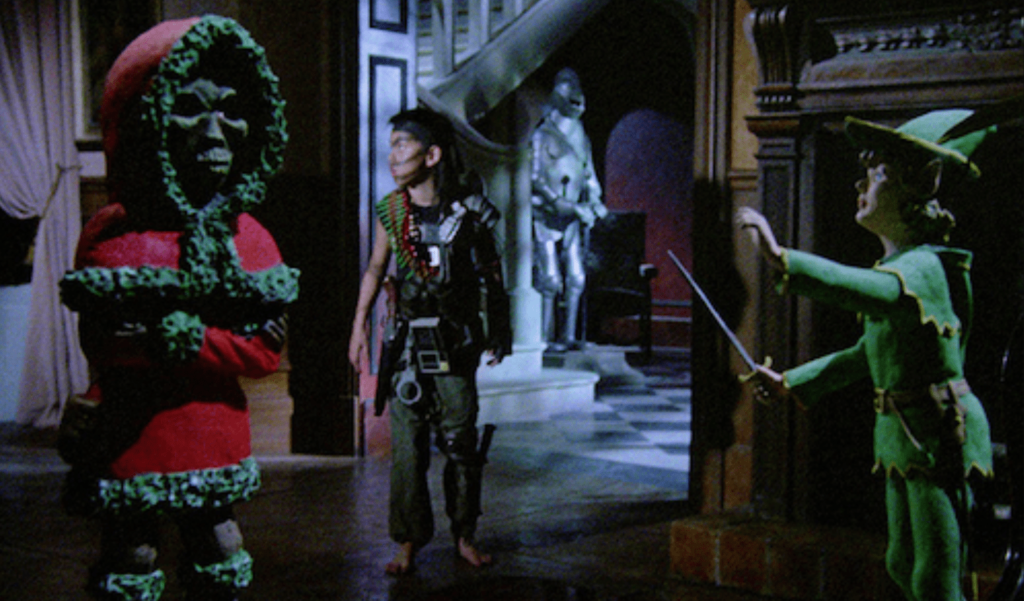
3615 code Père Noël (1989) is my favorite Christmas movie. Not only is this film a terribly effective genre piece but it also captures all of the childhood wonder and imagination evoked by Christmas. René Manzor’s film accomplishes the difficult task of creating a world in which cartoonish action can exist alongside very real violence and disillusionment. 3615 code Père Noël is a nightmare of Christmas where all that is beautiful about the holiday season is trampled under foot.
3615 code Père Noël tells the story of a little boy named Thomas (Alain Lalanne). Thomas lives in a mansion with his mother (Brigitte Fossey) and grandfather (Louis Ducreux) where he spends his days entertaining himself in a secret room with thousands of toys or writing computer programs or installing security cameras or re-enacting his favorite moments from eighties action movies. Thomas is a character whose very existence is dependent upon his imagination.
Manzor’s film takes Thomas’ imagination seriously for it is an extension of the film’s protagonist. 3615 code Père Noël was shot primarily on sound stages and Manzor seizes the opportunity to create the set for the mansion in which Thomas and his family live to the specifications of Thomas’ imagination. Rooms and secret passages can be found in this mansion that defy all logic except for that of Thomas’ ten year old mind. All the action in 3615 code Père Noël that takes place at the mansion becomes subject to Thomas’ interpretations.
Thomas believes in Santa Claus, he believes in goblins and fairies, and he believes in aliens. His active imagination gives credibility to the unreal; to the things he cannot disprove. When the disturbed killer dressed as Santa (Patrick Floersheim) arrives and terrorizes Thomas and his grandfather with a violent game of hide and seek on Christmas Eve, the unrealities that Thomas believes in are turned back on him aggressively. To Thomas the real Santa Claus kills his beloved dog J.R., the real Santa stabs him in the leg, and the real Santa is gunned down in the end. 3615 code Père Noël is a disturbing meditation on innocence lost.
Despite the darker, terrifying moments of 3615 code Père Noël Manzor never loses touch with the depth and limitations of Thomas’ ten year old imagination. This lends the film moments of levity. Once Thomas hides his grandfather in a suit of armor on display in the mansion’s hall one can’t help but think “of course that is where a kid would think to hide”. Even a few of the moments of violent confrontation between Santa and Thomas take on an imaginative form. In these instances Manzor recreates moments from Predator (1987) and Rambo: First Blood Part II (1985) so that the audience sees Thomas as he imagines himself as filtered through his favorite films.
3615 code Père Noël has a lot to say about how our viewing experiences that we have as a kid help to shape our internal lives. It’s important to note that in 3615 code Père Noël the same fantasies serve Thomas in moments of play and in moments of severe trauma. The relationship Thomas has with cinema is more complex and nuanced then similar relationships in other films like Radio Flyer (1992) or Secondhand Lions (2003).
It’s generally accepted that 3615 code Père Noël was the basis for John Hughes’ Home Alone (1990). The similarities are undeniable and the two films were released within a year of each other. However Hughes’ production doesn’t trade in the same high stakes or themes as 3615 code Père Noël. Hughes is perfectly content to do nothing more than to soothe his audience with a white upper class fantasy of survival.
3615 code Père Noël is a disturbing film in many ways but it isn’t the despicably empty, hollow experience of Home Alone. Cutesy platitudes and Rockwellian posturing can only be suffered for so long. 3615 code Père Noël is a beautiful, intricate and ultimately moving film that I wish would replace Hughes’ gross little fantasy within our popular imagination.
